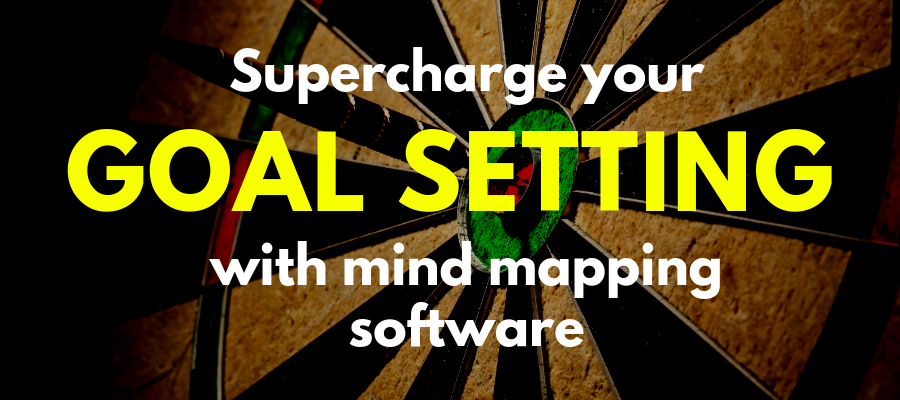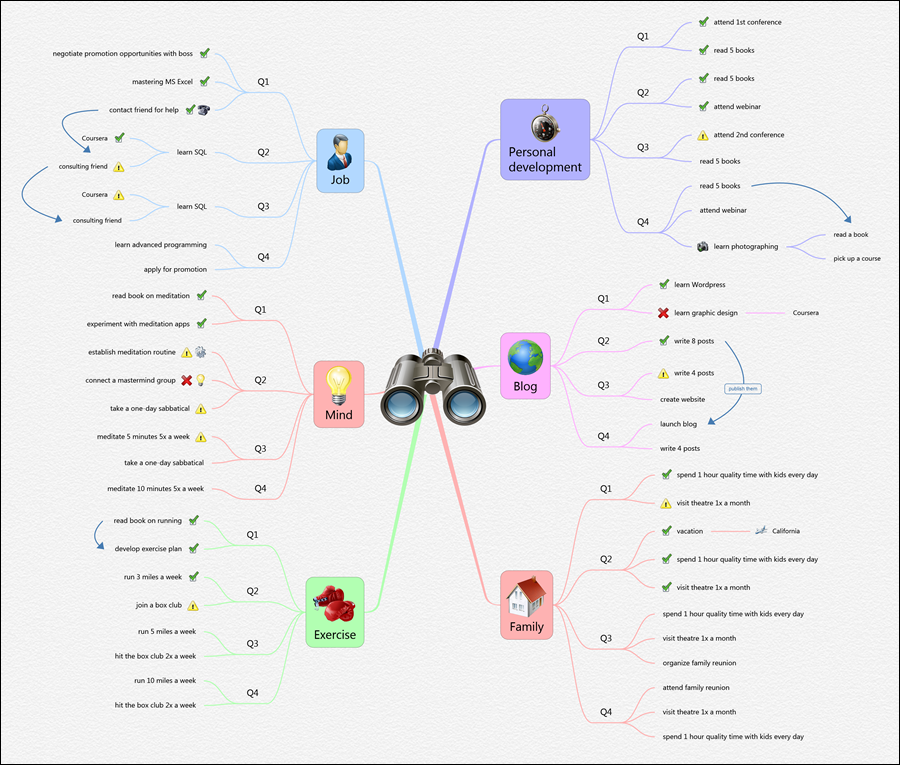When it comes to visualizing your goals in a way that compels action and drives you toward achievement, nothing beats mind mapping. It’s the ultimate goal setting technique.
Deep down, everyone wants to achieve something or improve their life in some way. Everyone has goals deep in their heart. The majority of us do not take the time and effort to articulate these goals because we think it’s a waste of time or because we’re skeptical about goal setting.
There is, however, ample evidence that writing down our goals will hold us more accountable and will make us more likely to succeed. Studies suggest that by visualizing our goals, we are more likely to shift gears and get from A to B. The question remains: How to capture our goals and turn them into actions?
There are a number of tools and templates you can work with. You can use a physical journal, a note-taking app such as Evernote or a task manager. All of those are great tools, but there is one method that outperforms its competitors when it comes to visualizing your goals: mind mapping.
What is mind mapping?
Mind mapping was invented and popularized by Tony Buzan in the 1960s. A mind map pictures the brain’s radiant thinking process. Mind mapping improves memory recall, helps finding connections between ideas and gaining a big picture view. Mind mapping can be used to virtually anything, from brainstorming to project planning to learning. (By the way, I outlined this blog post in a mind map.) I encourage you to read Tony Buzan’s Mind Map Book. This is a good place to start. Mind mapping can be really mind-opening.
I was introduced into mind mapping in David Allen’s landmark book Getting Things Done. The author demonstrated mind mapping in a very simplistic scenario―moving the office. A hand-crafted mind map was presented; it was so simple yet powerful. Ever since I met this page, I created dozens of mind maps for my personal and professional projects, meetings, goals, schedules, and more. Mind mapping is so fun that every time I’m faced with a problem or large project, I ask myself whether I could make a mind map to address the issue.
The power of engagement and goal setting
Let’s get back to goal setting. High achievers have their goals posted on the wall so that they can quickly review them each morning. A mind map can be kind of an artwork, something that you fully engage with and this is the key when it comes to goal setting. It is extremely important that you internalize your goals and mind mapping is a good candidate to do the trick for you.
By creating a visual representation of your grandest goals, you are more likely to engage with them, recall them and connect the dots between A and B. Pull out your notebook right now and set a goal to learn mind mapping by the end of the year.
The creation of a mind map begins with a central idea which, at best, is an image that captures the main topic. Then, as part of your brainstorming, add branches to your mind map. Your branches will represent your goals, and your sub-branches will account for your sub-goals and tasks. Make sure that you use colours, images, dimensions and contrast to enliven your mind map. You can establish links between different goals. For example, accomplishment of goal 1 will generate momentum and pave the way for goal 2.
Let’s create your goal map
Let’s see how to construct your annual goals in a form of a mind map. Begin with a central idea (“my goals”) and then add as many branches to your mind map as you have goals for the calendar year. Experts suggest that you keep the number under 10. Add four sub-branches to each of your goals representing the quarters (Q1, Q2, Q3, Q4). Now you can allocate tasks to your goals before each quarter begins.
You may list a few key tasks at the very beginning of the year for Q1, maybe Q2. Then, as time progresses, fill in Q3 and Q4. Try to establish links between branches (goals and tasks).
Michael Hyatt suggests that you write 3-5 key motivations to each of your goals as well as identify a form of celebration when your goal is accomplished. These can all be incorporated into a mind map―either as comments or as callouts. If you find you’re losing your underlying motivation for pursuing your goals, refer back to them to reconnect to the power of your goals.
“OK, but how do I retrieve information from a complex mind map?” you may ask. When it comes to accomplishing tasks, you can either use your mind map as a facilitator, or you can export or copy and paste your tasks into your task manager. Some mind mapping tools offer a “focus mode” showing only a single goal or task that you are working on. This map view can help you to escape the clutter of a complex mind map.
Track your progress toward your goals
Every goal achiever knows that planning is only half the battle. You must track your progress and adjust your plan accordingly. A physical notebook or a digital one are awesome tools, but why not track your progress in your mind map? Although mind mapping tools do not allow writing long progress reports, they do offer a fairly good solution.
A handful of mind mapping tools offer basic task management functionalities, but I would suggest a simpler method: you can use icons to represent the status of your goals. Nothing beats a tick mark when it comes to celebrating a goal attained. You can mark some goals with an exclamation mark to capture attention. Some tools enable setting due dates and syncing your mind map with your favourite calendar app. You can add comments to all of your goals. You can easily customize your goal map with a tracking scheme that works best for you.
Once you’re finished creating your goal map, it’s best to distance yourself from it. Revisit it the next day or the next week. You can put it on the wall or save it to Evernote and add it to its shortcuts. Be sure that you review your mind map every single morning to bring your goals back to top-of-mind. This increases the odds that you will complete them.
Which tool is best to create your goal map?
What mind mapping tools work best for creating goal maps. I have experimented with iThoughts, XMind, MindMeister and iMindMap. Each has its own strengths and weaknesses. Your experiences with them will depend upon the way in which you think and work. I encourage you to experiment with several mind mapping software programs to learn which one works best for you.
I recommend that you choose a tool that enables you to view and update your goal map across multiple platforms – such as a desktop computer, mobile app and web-based version. This will ensure that you have access to the latest version of your map at all times.
If you prefer paper, why not draw your own mind map and personalize it with hand-drawn images, icons and colors. Later on, you can digitize your mind map.
Whatever tool you choose don’t forget that the only way you will reach your goals is with a dedicated and disciplined mind.
Csaba Vadadi-Fulop is a Hungary-based biologist PhD, currently working in the R&D field. In line with his burning enthusiasm for productivity, he started to writing blog posts. Csaba can be reached on LinkedIn. The mind map above was created using iThoughts.



Leave a Reply